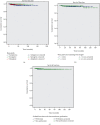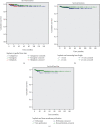15-Year Retrospective Study on the Success Rate of Maxillary Sinus Augmentation and Implants: Influence of Bone Substitute Type, Presurgical Bone Height, and Membrane Perforation during Sinus Lift
- PMID: 36860810
- PMCID: PMC9970713
- DOI: 10.1155/2023/9144661
15-Year Retrospective Study on the Success Rate of Maxillary Sinus Augmentation and Implants: Influence of Bone Substitute Type, Presurgical Bone Height, and Membrane Perforation during Sinus Lift
Abstract
Objectives: To evaluate the success rate of bone grafts and implants carried out at the Latin American Institute for Research and Dental Education (ILAPEO), considering the following: (i) the different pure bone substitutes (autogenous, xenogeneic, and alloplastic), (ii) the presurgical bone height, and (iii) how the treatment is compromised when membrane perforation occurs during sinus lift in maxillary sinus surgeries. Material and Methods. The initial sample comprised 1040 records of maxillary sinus lifting surgeries. After evaluation, the final sample retained 472 grafts performed using the lateral window technique with a total of 757 implants. The grafts were divided into 3 groups: (i) autogenous bone (n = 197), (ii) xenogenous bovine bone (n = 182), and (iii) alloplastic material (n = 93). One calibrated examiner classified the sample into two groups based on the residual bone height (<4 mm and ≥4 mm) of the area of interest measured on parasagittal sections of tomographic images. Data on membrane perforation occurrences in each group were collected; qualitative variables were described using frequency, expressed as percentages. The Chi-square test was used to analyze the success of the graft types and the survival rate of the implants as a function of the grafted material and the residual bone height. The Kaplan-Meier survival analysis was used to calculate the survival rate of bone grafts and implants according to the classifications adopted in this retrospective study.
Results: The success rate of grafts and implants was 98.3% and 97.2%, respectively. There was no statistically significant difference in the success rate among the different bone substitutes (p = 0.140). Only 8 grafts (1.7%) and 21 implants (2.8%) failed. There was a greater success rate for both grafts (96.5%) and implants (97.4%) when the bone height was ≥4 mm. The success rate in the 49 sinuses in which the membrane was perforated was 97.96% for the grafts and 96.2% for the implants. The follow-up periods after rehabilitation ranged from 3 months to 13 years.
Conclusions: Within the limitations of the data analyzed in this retrospective study, maxillary sinus lift was a viable surgical technique that enabled implant placement with a predictable long-term success rate, regardless of the type of material used. The presence of membrane perforation did not interfere with the success rate obtained for grafts and implants.
Copyright © 2023 Vanessa Helena Jamcoski et al.
Conflict of interest statement
The authors declare that they have no conflicts of interest.
Figures





Similar articles
-
A clinical long-term radiographic evaluation of graft height changes after maxillary sinus floor augmentation with a 2:1 autogenous bone/xenograft mixture and simultaneous placement of dental implants.Clin Oral Implants Res. 2004 Jun;15(3):339-45. doi: 10.1111/j.1600-0501.2004.00996.x. Clin Oral Implants Res. 2004. PMID: 15142097
-
Early loading of implants in the atrophic posterior maxilla: lateral sinus lift with autogenous bone and Bio-Oss versus crestal mini sinus lift and 8-mm hydroxyapatite-coated implants. A randomised controlled clinical trial.Eur J Oral Implantol. 2009 Spring;2(1):25-38. Eur J Oral Implantol. 2009. PMID: 20467616 Clinical Trial.
-
Sinus bone graft using new alloplastic bone graft material (Osteon)-II: clinical evaluation.Oral Surg Oral Med Oral Pathol Oral Radiol Endod. 2010 Mar;109(3):e14-20. doi: 10.1016/j.tripleo.2009.10.047. Oral Surg Oral Med Oral Pathol Oral Radiol Endod. 2010. PMID: 20219580
-
Influence of Schneiderian Membrane Perforation on Implant Survival Rate: Systematic Review and Meta-Analysis.J Clin Med. 2024 Jun 27;13(13):3751. doi: 10.3390/jcm13133751. J Clin Med. 2024. PMID: 38999315 Free PMC article. Review.
-
Maxillary sinus augmentation using sinus membrane elevation without grafts - A Systematic Review.J Indian Prosthodont Soc. 2016 Oct-Dec;16(4):317-322. doi: 10.4103/0972-4052.191289. J Indian Prosthodont Soc. 2016. PMID: 27746593 Free PMC article. Review.
Cited by
-
Three Milliliters of Peripheral Blood Is Sufficient for Preparing Liquid Platelet-Rich Fibrin (PRF): An In Vitro Study.Bioengineering (Basel). 2024 Mar 4;11(3):253. doi: 10.3390/bioengineering11030253. Bioengineering (Basel). 2024. PMID: 38534527 Free PMC article.
-
Automatic detection of posterior superior alveolar artery in dental cone-beam CT images using a deeply supervised multi-scale 3D network.Dentomaxillofac Radiol. 2024 Jan 11;53(1):22-31. doi: 10.1093/dmfr/twad002. Dentomaxillofac Radiol. 2024. PMID: 38214942 Free PMC article.
-
Clinical and radiographic outcomes of extra-short implants (≤ 6 mm) in the posterior atrophic jaws: a retrospective cohort study.Int J Implant Dent. 2025 Jan 20;11(1):4. doi: 10.1186/s40729-025-00592-z. Int J Implant Dent. 2025. PMID: 39832106 Free PMC article.
-
Does sinus membrane thickness influence the risk of perforation during lateral sinus lift surgery for dental implants? a systematic review and meta-analysis.Med Oral Patol Oral Cir Bucal. 2024 Jul 1;29(4):e568-e574. doi: 10.4317/medoral.26545. Med Oral Patol Oral Cir Bucal. 2024. PMID: 38794940 Free PMC article.
-
Evaluation of Surgical Outcomes of Zygomatic Implant-Supported Rehabilitation of Atrophic Maxillary Arches - A Prospective Study.Ann Maxillofac Surg. 2024 Jan-Jun;14(1):27-32. doi: 10.4103/ams.ams_32_23. Epub 2024 Jul 19. Ann Maxillofac Surg. 2024. PMID: 39184428 Free PMC article.
References
-
- Johansson L. A., Isaksson S., Lindh C., Becktor J. P., Sennerby L. Maxillary sinus floor augmentation and simultaneous implant placement using locally harvested autogenous bone chips and bone debris: a prospective clinical study. Journal of Oral Maxillofacial Surgery . 2010;68(4):837–844. doi: 10.1016/j.joms.2009.07.093. - DOI - PubMed
-
- Lambert F., Lecloux G., Rompen E. One-step approach for implant placement and subantral bone regeneration using bovine hydroxyapatite: a 2- to 6-year follow-up study. The International Journal of Oral & Maxillofacial Implants . 2010;25(3):598–606. - PubMed
-
- Del Fabbro M., Testori T., Francetti L., Weinstein R. Systematic review of survival rates for implants placed in the grafted maxillary sinus. The International Journal of Periodontics & Restorative Dentistry . 2004;24(6):565–577. - PubMed
MeSH terms
Substances
LinkOut - more resources
Full Text Sources

